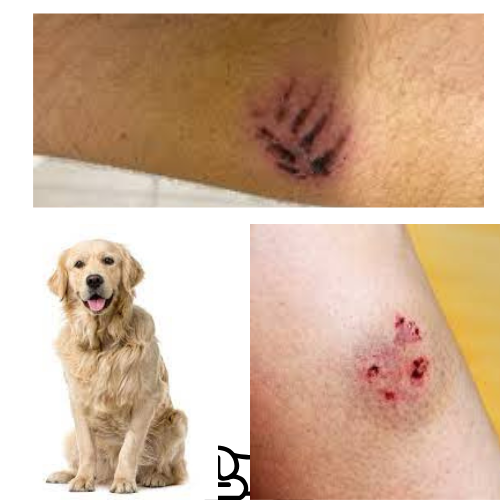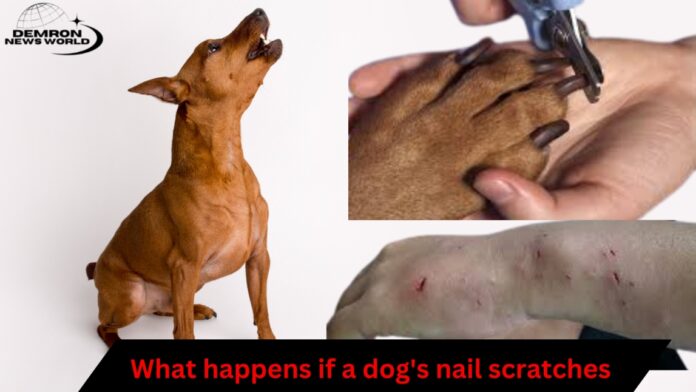Dogs are friendly animals; unfortunately, they always want to play and can scratch you by accident. When a dog scratches its nails on the wall, it may seem minor, nonetheless, information regarding the dangers and how to eliminate them is crucial. Objects of this article are to describe the causes of dog nail scratches, possible complications that may occur, and the ways how to prevent a dog from scratching the nails on a specific surface. By the time you’ve reached the end, you’ll feel fairly prepared to handle any circumstance related to a dog’s nail scratch.
Understanding Dog Nail Scratches
Dog claws tend to be sharp especially when they haven’t been cut in a while. If a dog scratches you, its claw can leave marks on your skin ranging from small to big. How bad the scratch is depends on how deep it goes where it is, and how clean the dog’s claws are.
Dogs spend a lot of time outdoors, so their claws collect germs and dirt. This means even a small scratch can get infected if you don’t treat it. Here’s what you need to do right after a dog scratches you.
Immediate Steps to Take After a Dog Nail Scratch
Clean the wound:
Since it is a small scratched area, clean it with soap and warm water. This helps in removing dirt, germs, and other things present in the wound.
Disinfect the area:
Use water or any kind of antiseptic solution like hydro peroxide and rubbing alcohol on the wound to eliminate bacteria. This prevents it from getting infected. Thus, try to know how to prevent it from getting infected.
Stop bleeding:
Press with a cotton cloth or bandage to check for any kind of bleeding. However, if the bleeding continues, a doctor should be consulted.
Apply antibiotic ointment:
Apply antibiotic ointment, available in pharmacies and over the counter, on the affected area to avoid infection. You can keep a clean bandage over it for a while.
Keep an eye out for signs of infection:
Remember to pay attention to things like the wound becoming red, swollen, hot to the touch, or oozing pus. These may indicate that it is infected and hence a doctor’s advice is necessary.
Potential Risks of a Dog Nail Scratch

1. Infection
The following are some of the diseases you can get from dog nails: If the bacteria Staphylococcus or Pasteurella sp Sp Sp infect your skin, the dog nails can contain the germs. These can cause an infection in the area of the scratch or the whole body. It is characterized by erythema, edema, and heat and usually occurs in the early days of wound healing.
2. Tetanus
Tetanus is a serious disease that results from the action of Clostridium tetani bacteria. Sometimes these bacteria are able to enter the bloodstream. To minimize this risk it is advisable to ensure that the tetanus vaccine is up-to-date.
3. Risk of rabies
However, other ways are formally possible: Scratching the nails of a mad dog contaminated with saliva can be theoretically dangerous. If you are unsure about the dog’s rabies vaccine, it is advisable to see a doctor immediately.
4. Allergic reactions
To be more precise, some people develop an immediate allergic reaction to dog scratches. Some of the symptoms associated with this skin condition are inflammation and rashes that are usually red, itchy, and swollen. In some cases, severe reactions require the use of antihistamines or corticosteroids.
5. Scars
Nursing care interventions should be promoted as deep scratches may cause scars, which are permanent. Wound management with the use of astringent creams helps to reduce scarring.
When to Seek Medical Attention
A dog nail scratch may seem like a minor injury, but there are some conditions that should prompt a doctor’s visit:
- Inflammation that remains constantly red, swollen, or painful
- Fever or chills
- Pus which is yellow or green at the site of the injury
- Paralysis of the affected part
- They affect the area around the eyes or mouth – scrapes.
If any of these signs and symptoms appear the patient should consult a doctor On the same note.
Preventing Dog Nail Scratches
1. Regular nail trimming
Trimming your pet’s nails helps minimize instances when your dog scratches itself by accident. Trim their nails occasionally using a clipper or grinder, probably once every two or three weeks.
2. Training and behavior modification
Teach your dog not to jump on people or play roughly with his mouth. This tends to encourage the behavioral growth that is appropriate.
3. Wear protective clothing
When playing with an excited dog it is preferable that the skin on one’s hand be covered by long sleeves or gloves in case one gets scratched.
4. Keep nails clean
Check if your dogs’ paws are in good condition particularly if your pet has gone out to play. It is easy to clean their paws and nails because washing with a wet cloth will remove dirt with bacteria.
Long-Term Effects of a Dog Nail Scratch
In most cases, nail scratch injuries do not leave permanent consequences on the dog’s body. But in some cases, especially where deep scratch injuries are involved if treated well, it can have good results. Severe cases may lead to chronic infection or scarring in the worst cases. The injury must be well cared for; hygiene must be maintained to prevent future complications.
Home Remedies for Healing Dog Nail Scratches
1. Aloe Vera Gel
Aloe vera has herbal anti-inflammatory healing properties and it cools any inflamed area. Apply fresh aloe vera gel on the affected area to heal the wound.
2. Honey
This is good for wound healing as raw honey is an antiseptic. Rub a little mixture on the scratch and then cover it with a bandage.
3. Turmeric Paste
You can mix the powder with water so that you get a paste. Use it on the scratch as it contains antimicrobial agents like curcumin.
4. Tea Tree Oil
Tea tree oil solution can be used to clean the affected area. But it should be mild enough to not cause rashes on the skin of people coming in contact with it.
Common Myths About Dog Nail Scratches
1. All dog scratches cause infection
They unfortunately do not realize that not every scratch results in infection. This risk is minimized significantly by good wound care.
2. Rabies is always a concern
Rabies infection from scratches is rare, particularly where the dog has been immunized against rabies. But if in doubt is always advisable to contact your veterinarian.
3. Scratches should not be looked down as
As are all other forms of abrasion, even slight ones should be cleaned.
Ned and monitored to avoid headaches.
Conclusion
Although they usually do not pose serious problems, dog nail scratches should not be taken lightly. Appropriate management of the wound; observation of signs and symptoms of infection, and physical examination to prevent complications will keep your dog fit and safe. It is important three: continual cutting or trimming of your dog’s nails and some facts concerning the risks of scratching. If you have followed the tips of this article, you should hopefully and easily control the dog nail scratches.
Frequently Asked Questions
Yes, a scratch can cause infection, tetanus, or other complications if not treated. Serious wounds should be examined by a doctor.
Itching, redness, pus formation, and warmth around the wound area or healing tissue. These can also mean that the person has a serious infection such as the flu or a bacterial infection.
If your tetanus vaccine is not valid or the scratch is deep, see a doctor for advice.
Rabies can be transmitted from scratch if the nail penetrates the skin with the saliva of a rabid dog, which is rare.
Bathe your dog frequently, train him to avoid jumping, and protect yourself from angry dogs.
Scratches can be treated and infections can be prevented with the help of aloe vera gel, honey, turmeric paste, and diluted tea tree oil.
